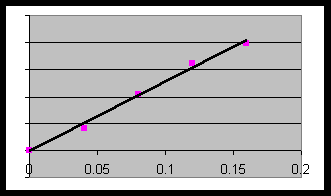
The table below represents water velocity vs. water depth, as inferred from stream range vs. depth by one student:
| depth | velocity |
0.16 m |
1.4 m/s |
0.12 |
1.3 |
0.08 |
|
0.04 |
0.64 |
0 |
0.04 |
To linearize this data we can take different powers of the velocity column and graph them vs. depth.
- the second power (the square),
- It is really easy to do this very quickly if you know how to use the fill handle in Excel.
One power that does not work is the -1 power (the reciprocal). Taking the reciprocals of the v column we get
| depth | velocity^-1 |
0.16 m |
. 7 |
0.12 |
. 77 |
0.08 |
|
0.04 |
1 .53 |
0 |
2 50 |
This transformation doesn't linearize very well at all, as can be easily seen by graphing y = velocity^-1 vs. depth.
Using a more appropriate power function (which you should find for yourself) the above data gives us the linearized graph below. The y axis isn't labeled, so you will have to find your own linearization.

We can use this linearization to get velocity v as a function of depth h:
You should now linearize the given data (or the data you have obtained for the experiment) using an appropriate power of v and using the appropriate units on your graph.